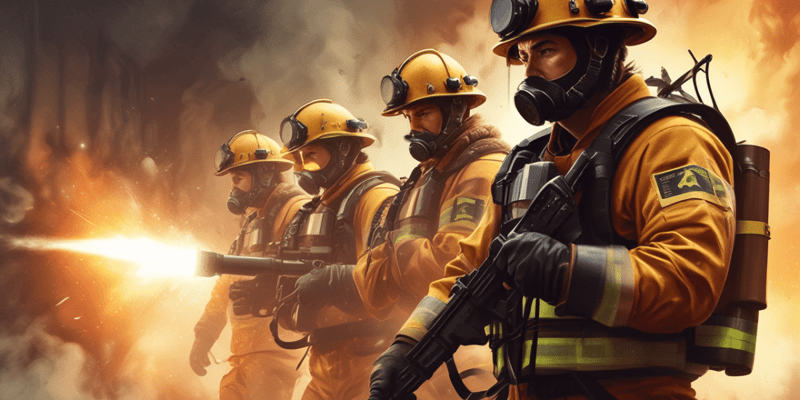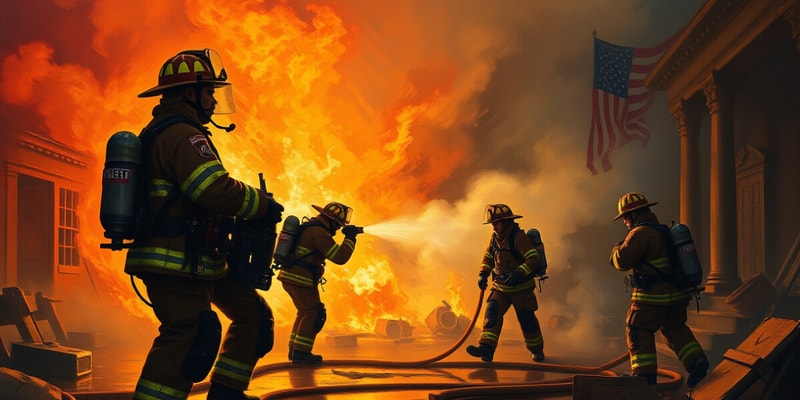Podcast Beta
Questions and Answers
What is one of the responsibilities of the initial arriving company as it pertains to aerial operations?
What minimum number of firefighters should be assigned to a Rapid Intervention Team (RIT)?
Which item is NOT typically included in the equipment for a Rapid Intervention Team?
Which option is one of the tasks that should be completed in preparation for aerial operations?
Signup and view all the answers
Which of the following is a role of Additional Chief Officers?
Signup and view all the answers
What should be established by the rapid intervention team immediately after personnel enter the hot zone?
Signup and view all the answers
Which of the following operations is NOT categorized under truck company operations?
Signup and view all the answers
What is the primary purpose of the utility control operation during fire incidents?
Signup and view all the answers
What is the primary purpose of conducting a 360° assessment of a building during a fire incident?
Signup and view all the answers
When conducting a 360° assessment, which of the following should NOT be included?
Signup and view all the answers
What should the Incident Commander (IC) consider when determining the mode of operation for fire management?
Signup and view all the answers
Which of the following actions is recommended if a flow path is identified during a 360° assessment?
Signup and view all the answers
What is a key component in the follow-up radio report after a 360° assessment?
Signup and view all the answers
What should the first arriving apparatus do if it is an engine company?
Signup and view all the answers
During the 360° assessment, why is it important to assess structural stability?
Signup and view all the answers
What should be established to ensure adequate fire control?
Signup and view all the answers
What is one of the responsibilities of the first arriving apparatus, even if it is a non-suppression unit?
Signup and view all the answers
Which of the following is NOT an action required from the first arriving aerial apparatus?
Signup and view all the answers
What should the first arriving chief officer do if command is already established upon arrival?
Signup and view all the answers
When positioning the first arriving aerial apparatus, what is considered an advantageous location?
Signup and view all the answers
Which of the following is an action that is part of truck company operations?
Signup and view all the answers
What is a required task associated with the first arriving apparatus's size-up assessment?
Signup and view all the answers
What is a key aspect of the first arriving aerial apparatus's operational readiness?
Signup and view all the answers
In the absence of hydrants, what should be prioritized regarding tanker apparatus placement?
Signup and view all the answers
What is the highest tactical priority during search and rescue operations?
Signup and view all the answers
Which attack method is specifically aimed at reducing the thermal threat within a structure?
Signup and view all the answers
What should the IC consider before deciding on the use of a handline during a transitional attack?
Signup and view all the answers
What is the correct angle for a firefighter to direct water during a transitional attack?
Signup and view all the answers
During a transitional attack, what should not be used according to the guidelines?
Signup and view all the answers
What is the primary purpose of fire suppression in the context of search and rescue operations?
Signup and view all the answers
What does the term 'neutral plane' refer to in fire suppression tactics?
Signup and view all the answers
In what scenario would the use of a master stream be warranted during a transitional attack?
Signup and view all the answers
What should be ensured before firefighters move into the structure to complete the extinguishment process?
Signup and view all the answers
When operating at a multiple-story structure, what is essential to prevent the return of thermal threat?
Signup and view all the answers
What aspect is NOT a focus when conducting a ventilation profile for a structure?
Signup and view all the answers
Why should backup lines be assigned during firefighting operations?
Signup and view all the answers
Which factor is NOT considered in an effective ventilation strategy?
Signup and view all the answers
What should be coordinated with suppression activities during ventilation efforts?
Signup and view all the answers
What is the primary purpose of conducting a ventilation profile before firefighting efforts?
Signup and view all the answers
What should the Incident Commander (IC) consider when determining extinguishment methods?
Signup and view all the answers
Study Notes
Operating at Structure Fire Incidents
- First arriving apparatus should conduct a 360° assessment, which includes identifying known rescue or potential rescue problems, flow path locations, the fire's location and extent, building size, age, and construction type, as well as assessing structural stability and identifying additional hazards.
- After the 360° assessment, the first arriving apparatus should conduct a 360° follow-up radio report that includes the results of the 360° assessment, reaffirms the Risk vs Benefit Analysis, any changes to the IAP, and the first arriving apparatus geographical location.
- If the first arriving apparatus is an engine company, they should position the apparatus with consideration in leaving room for an aerial device in front of the structure.
- First arriving aerial apparatus should position the unit in the most advantageous location for aerial operations, preparing to perform truck company operations such as search and rescue, ventilation, forcible entry, laddering the structures, salvage, overhaul, elevated streams, lighting, utility control, and deploying outriggers.
- The first arriving chief officer should contact the IC if command is already established, conduct a size-up of the incident and 360° assessment, and establish accountability.
- If the first arriving apparatus is a non-suppression unit, they are still responsible for completing the size-up, initial radio report, 360° assessment, 360° follow-up report, and apparatus placement instructions.
- The first on-deck company assigned by command should assume the duties and responsibilities of the Rapid Intervention Team (RIT), which should be assigned by the IC as soon as feasible following the entry of personnel into the designated hot zone.
- Additional chief officers should support the Incident Commander in roles such as division supervisor, group supervisor, accountability officer, resource officer, staging officer, and support officer (command aide).
- A transitional attack (resetting the fire) can be used to rapidly reduce the thermal threat in the interior of the structure and cool the environment for occupants and firefighters.
- The IC should ensure ventilation efforts are coordinated with the crews moving to an interior position for final extinguishment.
- When deciding to ventilate a structure, the IC should complete a ventilation profile of the building to ensure they recognize ventilation points showing the flow paths of heat and smoke as well as air movement into the structure.
- The IC should ensure management and control of all openings is occurring to limit the fire’s access to oxygen, and ventilation should be coordinated with suppression activities.
- When performing a ventilation profile, the IC should look for building construction, integrity, size, and occupancy type, location of smoke or fire venting from the structure, smoke’s volume, velocity, density, and color venting from the structure, and the direction and speed of the wind and its potential influence.
Studying That Suits You
Use AI to generate personalized quizzes and flashcards to suit your learning preferences.
Related Documents
Description
This quiz explores the crucial steps and considerations for first arriving apparatus at structure fire incidents. It covers the importance of conducting a thorough 360° assessment, strategic positioning of units, and effective communication during operations. Test your knowledge on fire incident management and response protocols.



